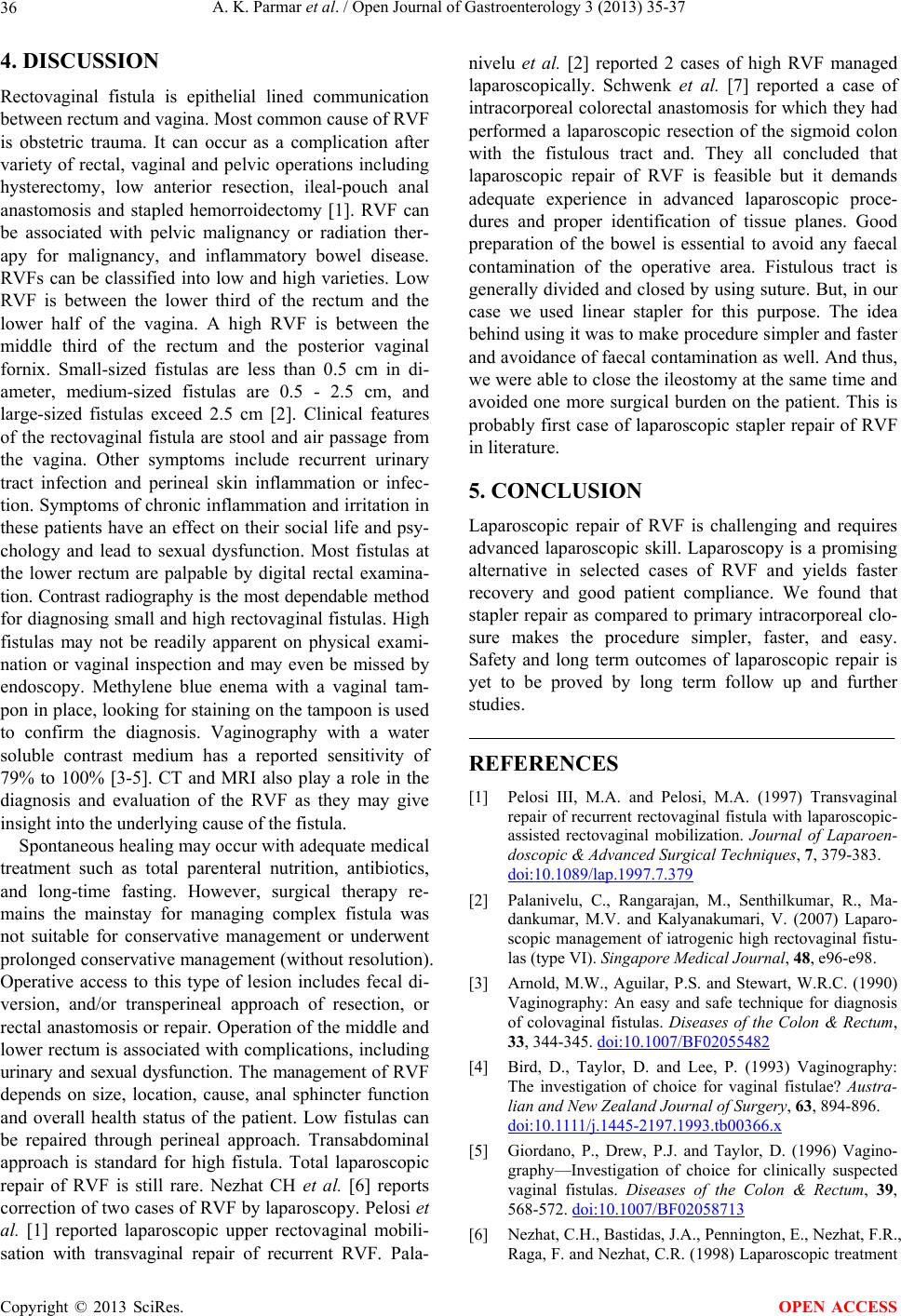
A. K. Parmar et al. / Open Journal of Gastroenterology 3 (2013) 35-37
36
4. DISCUSSION
Rectovaginal fistula is epithelial lined communication
between rectum and vagina. Most common cause of RVF
is obstetric trauma. It can occur as a complication after
variety of rectal, vaginal and pelvic operations including
hysterectomy, low anterior resection, ileal-pouch anal
anastomosis and stapled hemorroidectomy [1]. RVF can
be associated with pelvic malignancy or radiation ther-
apy for malignancy, and inflammatory bowel disease.
RVFs can be classified into low and high varieties. Low
RVF is between the lower third of the rectum and the
lower half of the vagina. A high RVF is between the
middle third of the rectum and the posterior vaginal
fornix. Small-sized fistulas are less than 0.5 cm in di-
ameter, medium-sized fistulas are 0.5 - 2.5 cm, and
large-sized fistulas exceed 2.5 cm [2]. Clinical features
of the rectovaginal fistula are stool and air passage from
the vagina. Other symptoms include recurrent urinary
tract infection and perineal skin inflammation or infec-
tion. Symptoms of chronic inflammat ion and irritation in
these patients have an effect on their social life and psy-
chology and lead to sexual dysfunction. Most fistulas at
the lower rectum are palpable by digital rectal examina-
tion. Contrast radiography is the most dependable meth od
for diagnosing small and high rectovaginal fistulas. High
fistulas may not be readily apparent on physical exami-
nation or vaginal inspection and may even be missed by
endoscopy. Methylene blue enema with a vaginal tam-
pon in place, looking for staining on the tampoon is used
to confirm the diagnosis. Vaginography with a water
soluble contrast medium has a reported sensitivity of
79% to 100% [3-5]. CT and MRI also play a role in the
diagnosis and evaluation of the RVF as they may give
insight into the un derlying cause of the fistula.
Spontaneous healing may occur with adequate medical
treatment such as total parenteral nutrition, antibiotics,
and long-time fasting. However, surgical therapy re-
mains the mainstay for managing complex fistula was
not suitable for conservative management or underwent
prolonged conservative management (without resolution).
Operative access to this type of lesion includes fecal di-
version, and/or transperineal approach of resection, or
rectal anastomosis or repair. Operation of the middle and
lower rectum is associated with complications, including
urinary and sexual dysfunction. The management of RVF
depends on size, location, cause, anal sphincter function
and overall health status of the patient. Low fistulas can
be repaired through perineal approach. Transabdominal
approach is standard for high fistula. Total laparoscopic
repair of RVF is still rare. Nezhat CH et al. [6] reports
correction of two cases of RVF by laparoscopy. Pelosi et
al. [1] reported laparoscopic upper rectovaginal mobili-
sation with transvaginal repair of recurrent RVF. Pala-
nivelu et al. [2] reported 2 cases of high RVF managed
laparoscopically. Schwenk et al. [7] reported a case of
intracorporeal colorectal anastomosis for which they had
performed a laparoscopic resection of the sigmoid colon
with the fistulous tract and. They all concluded that
laparoscopic repair of RVF is feasible but it demands
adequate experience in advanced laparoscopic proce-
dures and proper identification of tissue planes. Good
preparation of the bowel is essential to avoid any faecal
contamination of the operative area. Fistulous tract is
generally divided and closed by using suture. But, in our
case we used linear stapler for this purpose. The idea
behind using it was to make procedure simpler and faster
and avoidance of faecal contamination as well. And thus,
we were able to close the ileostomy at the same time and
avoided one more surgical burden on the patient. This is
probably first case of laparoscopic stapler repair of RVF
in literature.
5. CONCLUSION
Laparoscopic repair of RVF is challenging and requires
advanced laparoscopic skill. Laparoscopy is a promising
alternative in selected cases of RVF and yields faster
recovery and good patient compliance. We found that
stapler repair as compared to primary intracorporeal clo-
sure makes the procedure simpler, faster, and easy.
Safety and long term outcomes of laparoscopic repair is
yet to be proved by long term follow up and further
studies.
REFERENCES
[1] Pelosi III, M.A. and Pelosi, M.A. (1997) Transvaginal
repair of recurrent rectovaginal fistula with laparoscopic-
assisted rectovaginal mobilization. Journal of Laparoen-
doscopic & Advanced Surgical Techniques, 7, 379-383.
doi:10.1089/lap.1997.7.379
[2] Palanivelu, C., Rangarajan, M., Senthilkumar, R., Ma-
dankumar, M.V. and Kalyanakumari, V. (2007) Laparo-
scopic management of iatrogenic high rectovaginal fistu-
las (type VI). Singapore Medical Journal, 48, e96- e 9 8.
[3] Arnold, M.W., Aguilar, P.S. and Stewart, W.R.C. (1990)
Vaginography: An easy and safe technique for diagnosis
of colovaginal fistulas. Diseases of the Colon & Rectum,
33, 344-345. doi:10.1007/BF02055482
[4] Bird, D., Taylor, D. and Lee, P. (1993) Vaginography:
The investigation of choice for vaginal fistulae? Austra-
lian and New Zealand Journal of Surgery, 63, 894-896.
doi:10.1111/j.1445-2197.1993.tb00366.x
[5] Giordano, P., Drew, P.J. and Taylor, D. (1996) Vagino-
graphy—Investigation of choice for clinically suspected
vaginal fistulas. Diseases of the Colon & Rectum, 39,
568-572. doi:10.1007/BF02058713
[6] Nezhat, C.H., Bastidas, J.A., Pennington, E., Nezhat, F.R.,
Raga, F. and Nezhat, C.R. (1998) Laparoscopic treatment
Copyright © 2013 SciRes. OPEN ACCESS